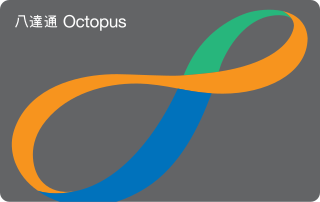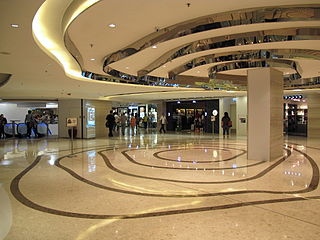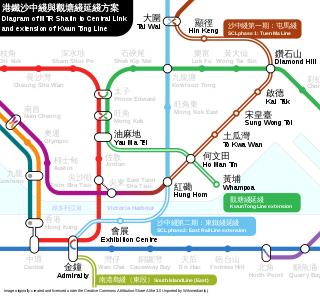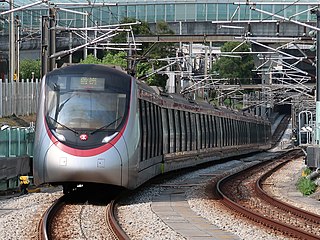


Two Hong Kong railway companies merged operations in 2007: the Kowloon-Canton Railway (KCR) and the Mass Transit Railway (MTR).



Two Hong Kong railway companies merged operations in 2007: the Kowloon-Canton Railway (KCR) and the Mass Transit Railway (MTR).
There had already been some discussion of merging the KCRC itself, which was also government-owned, and the MTR to make the territory's transport system more efficient. The MTR Corporation Limited (MTRCL) backed such a merge while the KCRC opposed the plan. In March 2004, the Hong Kong Government officially encouraged the two companies to merge.
On 11 April 2006, the Hong Kong Government officially announced the details of the proposed merger. Under the non-binding Memorandum of Understanding the Government has signed with KCRC, KCRC would grant a Service Concession to the MTRCL to operate the KCR system, with an initial period of 50 years. The KCRC would receive a one-time upfront payment of HK$4.25 billion, a fixed annual payment of HK$750 million and a variable annual payment based on revenues generated from operation of the KCR system. In addition, MTRCL would make a payment of $7.79 billion for the acquisition of property and other related commercial interests. [1]
The railway lines the KCRC operated were less profitable than the MTRC, and the KCRC was less active in property development. It was widely considered[ by whom? ] that the Government's choice was made to avoid being criticised for selling assets of the KCRC –which it wholly owned –to MTRCL at an underpriced level. Leasing the operation right of the KCR system to the MTRCL could avoid actually selling the KCRC.
On 2 December 2007, the Chinese name of the MTRCL was changed to 香港鐵路有限公司 [2] (Jyutping :hoeng1gong2 tit3lou6 jau5haan6 gung1si1; lit. 'Hong Kong Railway Corporation Limited') after being granted the Service Concession while the English name will remain unchanged. [3] [4] The KCRC became a holding company of the KCR system, without actual railway operations.
The merger, effective for 50 years, was approved by shareholders of the MTRCL on 9 October 2007. This also resulted in changing the system's Chinese name from "地鐵" ("Subway") to "港鐵" ("Hong Kong Railway").
All adult Octopus Card holders were the first to benefit from the merger. [5] Student and Concessionary Octopus holders also benefited from the merger by further reducing $0.1 from their 50% off fares. [6] Student Octopus holders would continue to pay the current reduced concessionary fares on the MTR network. Elderly Octopus holders would be introduced to a new fare system which only the elderly can enjoy a $2 fare to anywhere on the MTR network (excluding Airport Express, Light Rail, and Cross-Boundary Stations). [7]

The Mass Transit Railway (MTR) is a major public transport network serving Hong Kong. Operated by the MTR Corporation Limited (MTRCL), it consists of heavy rail, light rail, and feeder bus service centred on a 10-line rapid transit network serving the urbanised areas of Hong Kong Island, Kowloon, and the New Territories. The system included 240.6 km (149.5 mi) of rail as of 2022 with 167 stations, including 99 heavy rail stations, 68 light rail stops and one high-speed rail terminus.

The Octopus card is a reusable contactless stored value smart card for making electronic payments in online or offline systems in Hong Kong. Launched in September 1997 to collect fares for the territory's mass transit system, the Octopus card system became the world's second contactless smart card system, after the Korean Upass, and has since grown into a widely used payment system for all public transport in Hong Kong. Octopus's success has led to the development of the Navigo card in Paris, the Oyster card in London, the Opal card in New South Wales, NETS FlashPay, EZ-Link in Singapore, and other similar systems.

The Kowloon–Canton Railway was a railway network in Hong Kong. It was owned and operated by the Kowloon-Canton Railway Corporation (KCRC) until 2007. Rapid transit services, a light rail system, feeder bus routes within Hong Kong, and intercity passenger and freight train services to China on the KCR network, have been operated by the MTR Corporation since 2007.

The Kowloon-Canton Railway Corporation is a Hong Kong wholly government-owned railway and land asset manager. It was established in 1982 under the Kowloon-Canton Railway Corporation Ordinance for the purposes of operating the Kowloon–Canton Railway (KCR), and to construct and operate other new railways. On 2 December 2007, the MTR Corporation Limited (MTRCL), another railway operator in Hong Kong, took over the operations of the KCR network under a 50-year service concession agreement, which can be extended. Under the service concession, KCRC retains ownership of the KCR network with the MTRCL making annual payments to KCRC for the right to operate the network. The KCRC's activities are governed by the KCRC Ordinance as amended in 2007 by the Rail Merger Ordinance to enable the service concession agreement to be entered into with the MTR Corporation Limited.

The West Rail line was a rapid transit line that formed part of the Mass Transit Railway (MTR) system in Hong Kong until 27 June 2021. Coloured magenta on the MTR map, the line ran from Tuen Mun to Hung Hom, with a total length of 35.7 kilometres (22.2 mi), in 37 minutes. The railway connected the urban area of Kowloon and the new towns of Yuen Long, Tin Shui Wai and Tuen Mun in the northwestern New Territories.

The Light Rail, also known as the Light Rail Transit (LRT), officially the North-West Railway, is a light rail system in Hong Kong, serving the northwestern New Territories, within Tuen Mun District and Yuen Long District. The system operates over 1,435 mmstandard gauge track, using 750 V DC overhead power supply. It was once one of four systems comprising the KCR network in Hong Kong, before the MTR–KCR merger in 2007. It has a daily ridership of about 483,000 people.

Nam Cheong is a MTR interchange station located at ground level beneath West Kowloon Highway, in Sham Shui Po, Hong Kong opposite the Fu Cheong Estate. It is served by the Tung Chung and Tuen Ma lines and provides cross-platform interchange between platform 1 and platform 4. The livery of Nam Cheong station is pale yellow green.

The East Rail line is one of ten lines of the Mass Transit Railway (MTR) system in Hong Kong. It used to be one of the three lines of the Kowloon–Canton Railway (KCR) network. It was known as the KCR British Section (九廣鐵路英段) from 1910 to 1996, and the KCR East Rail (九廣東鐵) from 1996 to 2007. East Rail was the only railway line of the Kowloon-Canton Railway Corporation (KCRC) following the closure of the Sha Tau Kok Railway and before the construction of KCR West Rail.

The Ma On Shan line was a rapid transit line that formed part of the Mass Transit Railway (MTR) system in Hong Kong. Coloured brown on the MTR map, the line acted as a branch of the East Rail line that connects the new towns of Sha Tin and Ma On Shan in the northeastern New Territories.

MTR Corporation Limited is a majority government-owned public transport operator and property developer in Hong Kong which operates the Mass Transit Railway, the most popular public transport network in Hong Kong. It is listed on the Hong Kong Exchange and is a component of the Hang Seng Index. The MTR additionally invests in railways across different parts of the world, including franchised contracts to operate rapid transit systems in London, Sweden, Beijing, Hangzhou, Macau, Shenzhen, Sydney, and a suburban rail system in Melbourne.

Citylink Plaza is a building that stands above Sha Tin station on the MTR East Rail line in Hong Kong. It was developed and is owned by the Kowloon-Canton Railway Corporation (KCRC). The building, as well as the railway station, is connected to New Town Plaza, which is one of the largest shopping centres in Sha Tin District.

The Sha Tin to Central Link was an expansion project of the MTR public transport network in Hong Kong. It was divided into two sections and expanded the network’s heavy rail lines.

Kwu Tung is a planned underground infill station on the Lok Ma Chau spur line of the East Rail line of the MTR rapid transit network in Hong Kong. The station will be situated near Kwu Tung in North District, New Territories. It will act as the terminus of the proposed Northern Link.

The SP1900 EMU / SP1950 EMU or IKK Train is a model of train that runs on Hong Kong's Tuen Ma line. It was the second model of electric multiple unit rolling stock of the Kowloon-Canton Railway Corporation (KCRC), though they have been operated by MTR Corporation (MTRC) after it merged with KCRC in 2007.

The East Rail line Metro Cammell EMU was a model of electric multiple unit built in 1980–1990 by Metro-Cammell for the original Kowloon–Canton Railway in Hong Kong. The 29 sets were owned by and were originally operated by the Kowloon-Canton Railway Corporation (KCRC). They were operated by MTR Corporation (MTRC) after it merged with KCRC in 2007. Although another set of EMU trains from the same manufacturer operate on some of MTR's own lines, there are some significant differences between the two models, with the Metro Cammell EMUs of the original MTR being known as the Modernization Train.

The Tuen Ma line is a rapid transit line that forms part of the Mass Transit Railway (MTR) system in Hong Kong. Coloured brown on the map, the Tuen Ma line is 56.2 kilometres (34.9 mi) in length, making it the longest line of the MTR network. It has a total of 27 stations, more than any other in the MTR system.
Rapid transit in Hong Kong began in 1979 with part of the Modified Initial System of the MTR entered service. The section, then ran only between Shek Kip Mei and Kwun Tong stations, was subsequently extended and new lines were added by the operator, the Mass Transit Railway Corporation.

Hong Kong's rail network mainly comprises public transport trains operated by the MTR Corporation Limited (MTRC). The MTRC operates the metro network of the territory and the commuter rail network connecting the northeastern and northwestern New Territories to the urban areas. The operations of the territory's two leading railway companies, MTRC and the Kowloon-Canton Railway Corporation (KCRC), were merged in 2007 on grounds of economies of scale and cost effectiveness. The Hong Kong Government has an explicit stated transport policy of using railways as its transport backbone.
The fare adjustment mechanism is a system regulating the fare increment of public utilities, including the Mass Transit Railway Corporation Limited (MTR). Under the mechanism, adjustment of MTR fare no longer need to be approved by the Legislative Council nor the Executive Council. The MTR has no autonomy in its fare setting, and the fare has to be set in accordance with a fixed formula. Originally, the mechanism aims to limit the soaring MTR fare increment by a transparent formulaic approach. However, Hong Kong has recorded continuous inflation in recent years, the MTR fare has then kept rising since 2010. Such phenomenon was greatly criticised by the general public.